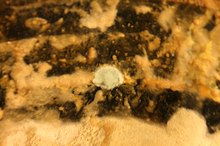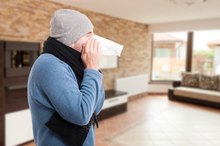What Are the Symptoms of a Sinus Fungal Infection?
Fungal sinusitis is an inflammatory infection of the sinuses caused by certain types of fungi 3. There are three major types of fungal sinus infections: fungus balls, allergic fungal sinusitis and invasive fungal sinusitis 234. The symptoms of these fungal sinus infection vary and range in severity from mild to severe. People who develop sinus infection symptoms should consult a doctor to ensure receipt of appropriate diagnosis and treatment.
If you are experiencing serious medical symptoms, seek emergency treatment immediately.
Fungus Balls
This type of sinus infection is caused by the overgrowth of fungi called fungus balls in normal, healthy people. People with this type of fungal sinus infection typically develop symptoms that mimic a bacterial sinus infection, reports the American Rhinologic Society 1. Such symptoms include nasal congestion, postnasal drip, and increased pressure or pain across the sinuses. Affected people may also experience long-lasting or recurrent sinus infections. Typically, surgical treatment is necessary to remove the fungal balls from the sinuses.
- This type of sinus infection is caused by the overgrowth of fungi called fungus balls in normal, healthy people.
- Typically, surgical treatment is necessary to remove the fungal balls from the sinuses.
Allergic Fungal Sinusitis
Smelly Mucus in the Nose
Learn More
Allergic fungal sinusitis is the most common type of fungal sinus infection 123. People with this fungal infection characteristically develop polyps, or growths of tissue, within the nasal passageways, reports The Merck Manuals Online Medical Library 2. Nasal polyps typically form in one nostril and may cause chronic inflammation and nasal congestion. Affected people may experience frequently stuffy or runny nasal passageways and can have difficulty breathing through the nose due to the presence of nasal polyps. Treatment with antibiotic or antifungal medications in conjunction with corticosteroids can help manage or reduce symptoms in infected people. Surgical treatment may also be necessary to remove nasal polyps and fungus from the sinuses.
- Allergic fungal sinusitis is the most common type of fungal sinus infection 1.
- Affected people may experience frequently stuffy or runny nasal passageways and can have difficulty breathing through the nose due to the presence of nasal polyps.
Invasive Fungal Sinusitis
Invasive fungal sinusitis is a severe condition that most frequently affects people who have poorly functioning immune systems, according to UpToDate 3. People with invasive fungal sinusitis may experience symptoms of fever or pain and may frequently expel pus from their nasal passageways 3. This type of infection may also spread to other body regions, such as the eye socket, warns The Merck Manuals Online Medical Library 2. People typically require surgery and antifungal medication to resolve invasive fungal sinusitis symptoms 3. If left untreated, this type of fungal sinus infection may be life-threatening.
Related Articles
References
- The Merck Manuals Online Medical Library: Sinusitis - Fungal SInus Infections
- UpToDate: Fungal Sinusitis
- Battisti AS, Pangia J. Sinusitis. [Updated 2019 Jun 18]. In: StatPearls [Internet]. Treasure Island (FL): StatPearls Publishing; 2019 Jan-. Available from: https://www.ncbi.nlm.nih.gov/books/NBK470383/
- InformedHealth.org [Internet]. Cologne, Germany: Institute for Quality and Efficiency in Health Care (IQWiG); 2006-. Sinusitis: Overview. 2009 Feb 9 [Updated 2018 Oct 18].Available from: https://www.ncbi.nlm.nih.gov/books/NBK279485/
- Kwon E, O'Rourke MC. Chronic Sinusitis. [Updated 2018 Nov 18]. In: StatPearls [Internet]. Treasure Island (FL): StatPearls Publishing; 2019 Jan-. Available from: https://www.ncbi.nlm.nih.gov/books/NBK441934/
- Treating Chronic Sinusitis. Informed Health Online: Institute for Quality and Efficiency in Health Care. https://www.ncbi.nlm.nih.gov/pubmedhealth/PMH0072668/.
- Hamilos DL. Chronic Rhinosinusitis (Beyond the Basics). UpToDate. https://www.uptodate.com/contents/chronic-rhinosinusitis-beyond-the-basics.
- Radojicic C. Sinusitis. Cleveland Clinic Center for Continuing Education. http://www.clevelandclinicmeded.com/medicalpubs/diseasemanagement/allergy/rhino-sinusitis/.
- Battisti AS, Pangia J. Sinusitis. [Updated 2019 Jun 18]. In: StatPearls [Internet]. Treasure Island (FL): StatPearls Publishing; 2019 Jan-.
- de Camargo RA, Nicodemo AC, Sumi DV, et al. Facial structure alterations and abnormalities of the paranasal sinuses on multidetector computed tomography scans of patients with treated mucosal leishmaniasis. PLoS Negl Trop Dis. 2014;8(7):e3001. Published 2014 Jul 31. doi:10.1371/journal.pntd.0003001
- Naclerio RM, Bachert C, Baraniuk JN. Pathophysiology of nasal congestion. Int J Gen Med. 2010;3:47–57. Published 2010 Apr 8.
- InformedHealth.org [Internet]. Cologne, Germany: Institute for Quality and Efficiency in Health Care (IQWiG); 2006-. Sinusitis: Overview. 2009 Feb 9 [Updated 2018 Oct 18].
- Worrall G. Acute sinusitis. Can Fam Physician. 2011;57(5):565–567.
- Ah-See KW, Evans AS. Sinusitis and its management. BMJ. 2007;334(7589):358–361. doi:10.1136/bmj.39092.679722.BE
- Benevides GN, Salgado GA Jr, Ferreira CR, Felipe-Silva A, Gilio AE. Bacterial sinusitis and its frightening complications: subdural empyema and Lemierre syndrome. Autops Case Rep. 2015;5(4):19–26. Published 2015 Dec 30. doi:10.4322/acr.2015.029
- Silveira MLC, Anselmo-lima WT, Faria FM, et al. Impact of early detection of acute invasive fungal rhinosinusitis in immunocompromised patients. BMC Infect Dis. 2019;19(1):310.
- Kwon E, O'Rourke MC. Chronic Sinusitis. [Updated 2018 Nov 18]. In: StatPearls [Internet]. Treasure Island (FL): StatPearls Publishing; 2019 Jan-.
- D'anza B, Stokken J, Greene JS, Kennedy T, Woodard TD, Sindwani R. Chronic invasive fungal sinusitis: characterization and shift in management of a rare disease. Int Forum Allergy Rhinol. 2016;6(12):1294-1300.
- Benevides GN, Salgado GA Jr, Ferreira CR, Felipe-Silva A, Gilio AE. Bacterial sinusitis and its frightening complications: subdural empyema and Lemierre syndrome. Autops Case Rep. 2015;5(4):19–26. Published 2015 Dec 30. doi:10.4322/acr.2015.029
- Ah-See KW, Evans AS. Sinusitis and its management. BMJ. 2007;334(7589):358–361. doi:10.1136/bmj.39092.679722.BE
- Lee S, Lane AP. Chronic rhinosinusitis as a multifactorial inflammatory disorder. Curr Infect Dis Rep. 2011;13(2):159–168. doi:10.1007/s11908-011-0166-z
- Jiang RS, Huang WC, Liang KL. Characteristics of Sinus Fungus Ball: A Unique Form of Rhinosinusitis. Clin Med Insights Ear Nose Throat. 2018;11:1179550618792254. Published 2018 Aug 3. doi:10.1177/1179550618792254
- Min JY, Tan BK. Risk factors for chronic rhinosinusitis. Curr Opin Allergy Clin Immunol. 2015;15(1):1–13. doi:10.1097/ACI.0000000000000128
- Zhang Z, Adappa ND, Lautenbach E, et al. The effect of diabetes mellitus on chronic rhinosinusitis and sinus surgery outcome. Int Forum Allergy Rhinol. 2014;4(4):315–320. doi:10.1002/alr.21269
- Lin YH, Chang TS, Yao YC, Li YC. Increased Risk of Chronic Sinusitis in Adults With Gastroesophgeal Reflux Disease: A Nationwide Population-Based Cohort Study. Medicine (Baltimore). 2015;94(39):e1642. doi:10.1097/MD.0000000000001642
- Pynnonen MA, Lynn S, Kern HE, et al. Diagnosis and treatment of acute sinusitis in the primary care setting: A retrospective cohort. Laryngoscope. 2015;125(10):2266–2272. doi:10.1002/lary.25363
- Novis SJ, Akkina SR, Lynn S, Kern HE, Keshavarzi NR, Pynnonen MA. A diagnostic dilemma: chronic sinusitis diagnosed by non-otolaryngologists. Int Forum Allergy Rhinol. 2016;6(5):486-90.
- Ah-See KW, Evans AS. Sinusitis and its management. BMJ. 2007;334(7589):358–361. doi:10.1136/bmj.39092.679722.BE
- Blin P, Blazejewski S, Lignot S, et al. Effectiveness of antibiotics for acute sinusitis in real-life medical practice. Br J Clin Pharmacol. 2010;70(3):418–428. doi:10.1111/j.1365-2125.2010.03710.x
- Potter PC, Pawankar R. Indications, efficacy, and safety of intranasal corticosteriods in rhinosinusitis. World Allergy Organ J. 2012;5(Suppl 1):S14–S17. doi:10.1097/WOX.0b013e31823f7216
- Ah-See KW, Evans AS. Sinusitis and its management. BMJ. 2007;334(7589):358–361. doi:10.1136/bmj.39092.679722.BE
- Treating Chronic Sinusitis. Informed Health Online: Institute for Quality and Efficiency in Health Care.
- Chow AW, Benninger MS, Brook I, et al. IDSA Clinical Practice Guideline for Acute Bacterial Rhinosinusitis in Children and Adults. Clin Infect Dis. 2012;54(8):e72–e112.
- Hamilos DL. Chronic Rhinosinusitis (Beyond the Basics).
- Radojicic C. Sinusitis. Cleveland Clinic Center for Continuing Education.
- Wald ER, Applegate KE, Bordley C, et al. Clinical Practice Guideline for the Diagnosis and Management of Acute Bacterial Sinusitis in Children Aged 1 to 18 Years. Pediatrics. 2013;132(1):e262-80.
Writer Bio
Rae Uddin has worked as a freelance writer and editor since 2004. She specializes in scientific journalism and medical and technical writing. Her work has appeared in various online publications. Uddin earned her Master of Science in integrated biomedical sciences with an emphasis in molecular and cellular biochemistry from the University of Kentucky College of Medicine.







